Acarpenter once came to work on my house carrying four heavy boxes of tool. I was taken by one elegant hand saw. “Japanese,” he said. “I don’t need it often, but when I do, it’s the right tool.” My carpenter knew “what to do when.” In other words, he had a theory that helped him know when to use which tool to accomplish the task before him. To me, that’s a practice theory: a model we keep in our heads that directs our action — it helps us know what to do when. Like all theories, it should be subject to constant testing and refinement as the data of the real world teaches us more and more about our tools and their impacts.
I had good teachers in organizational development, but none of them, except Chris Argyris, could articulate his or her practice theory. When I began to work with teams and organizations using Peter Senge’s The Fifth Discipline as a point of departure, I realized that the disciplines Senge describes are useful approaches, but that the approach lacked a practice theory — I couldn’t tell which discipline to use when. So, I took some bits and pieces of ideas from colleagues and I made one up. And since I’m a visual person, it’s a practice theory as a picture (see “The Learning Action Matrix”). I call it the Learning Action Matrix, though the name isn’t important.
What is important is that the Learning Action Matrix knits Senge’s learning disciplines into a system that provides a logical “map” to guide practitioners through a process that produces real results and continuous learning. It helps identify where you are in any given process, suggests what to do at any given point, and indicates where to go next.
Learning Action Matrix
Level of Reasoning
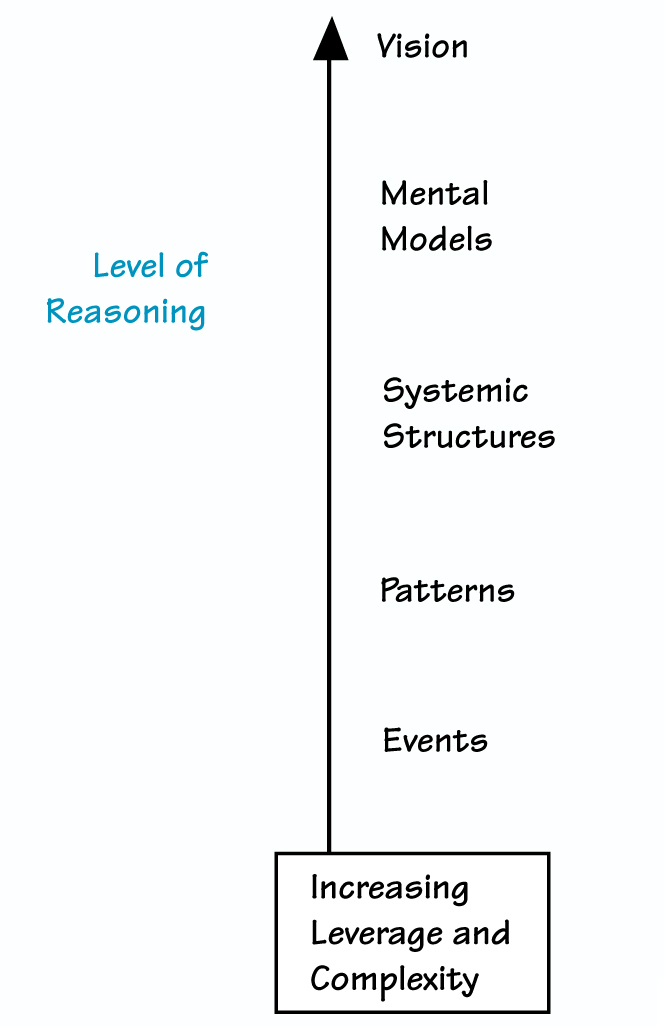
The vertical axis “Levels of Reasoning” is borrowed from Daniel Kim’s “Vision Deployment Matrix” (see “Levels of Understanding” in The Systems Thinker, June/July 1993). His work, in turn, owes a debt to the “Iceberg Model” from Innovation Associates’ Systems Thinking curriculum.
What is a matrix? A matrix is a grid with different elements on the horizontal and vertical axes. Each cell combines the attributes of the vertical and horizontal axes to create a unique meaning.
The Learning Action Matrix is a five by four (5 x 4) grid. Let’s understand each axis of the grid, and then see what happens when we combine these axes into a matrix.
On the vertical axis is listed “Level of Reasoning.” Each of these five levels represents different ways of seeing, frames through which situations can be viewed at increasing levels of complexity. The more complexity that can be brought into the conversation, the more potential for change.
All of these levels are informed by vision. The key question at this level is “What do we want to create?” or, taken retrospectively, “What do we seem to be creating?” These aspirations, stated or unstated, exert a powerful influence on the events, patterns, systemic structures, and mental models working in any given situation. Systemic structures, in turn, are frequently held in place by mental models — assumptions that may be undiscussable theories on what constitutes quality, good service, or an acceptable return on investment. These “theories in use” may also treat interpersonal dynamics, for example, approaches toward conflict or the correct way to interact with senior leaders. Once a pattern has been identified and described, it is possible to document the systemic dynamics that maintain it. The level of systemic structures marks the boundary between what can be easily observed in the objective world (events and patterns) and what must be assessed, often laboriously, from the data (mental models and vision). Systemic dynamics are abstractions, but they stay close to the data. The causal loop language is an example of this kind of thinking. There is nothing wrong in understanding the world as a series of events. It’s just not a very high-leverage way to approach problems. Leverage begins with pattern recognition, with the basic insight that “this has happened before.” Most discussions begin at the events level, with some version of “this is what happened.” Discussions on this level usually assign a single cause to each effect: “This happened because that happened.” Listen to an explanation of stock market behavior on any given day for a good example of reasoning at the events level. The horizontal axis of the matrix describes a four-phase iterative learning cycle: observe, assess, develop, and implement.
Learning begins with observation
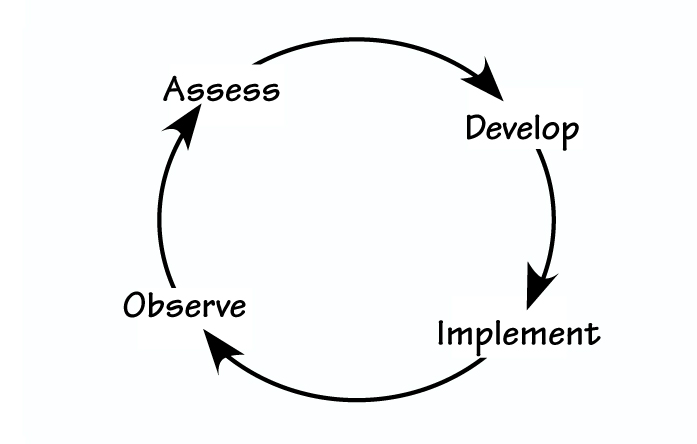
Learning begins with observation, with seeing what has occurred. An assessment or diagnosis is made about what one has observed — one develops a theory about what is going on. This theory influences the development of a response, which leads to the implementation of certain actions. These actions are observed, initiating a second trip through the cycle. When we combine the two axes described in the last section, we get the Learning Action Matrix (below).
Notice how the terms on the horizontal axis are verbs (“Observe”) and the terms on the vertical axis are nouns (“Events”). When we combine the two, we get a series of imperative sentences that we can group into four “Zones of Work.”
THE LEARNING ACTION MATRIX
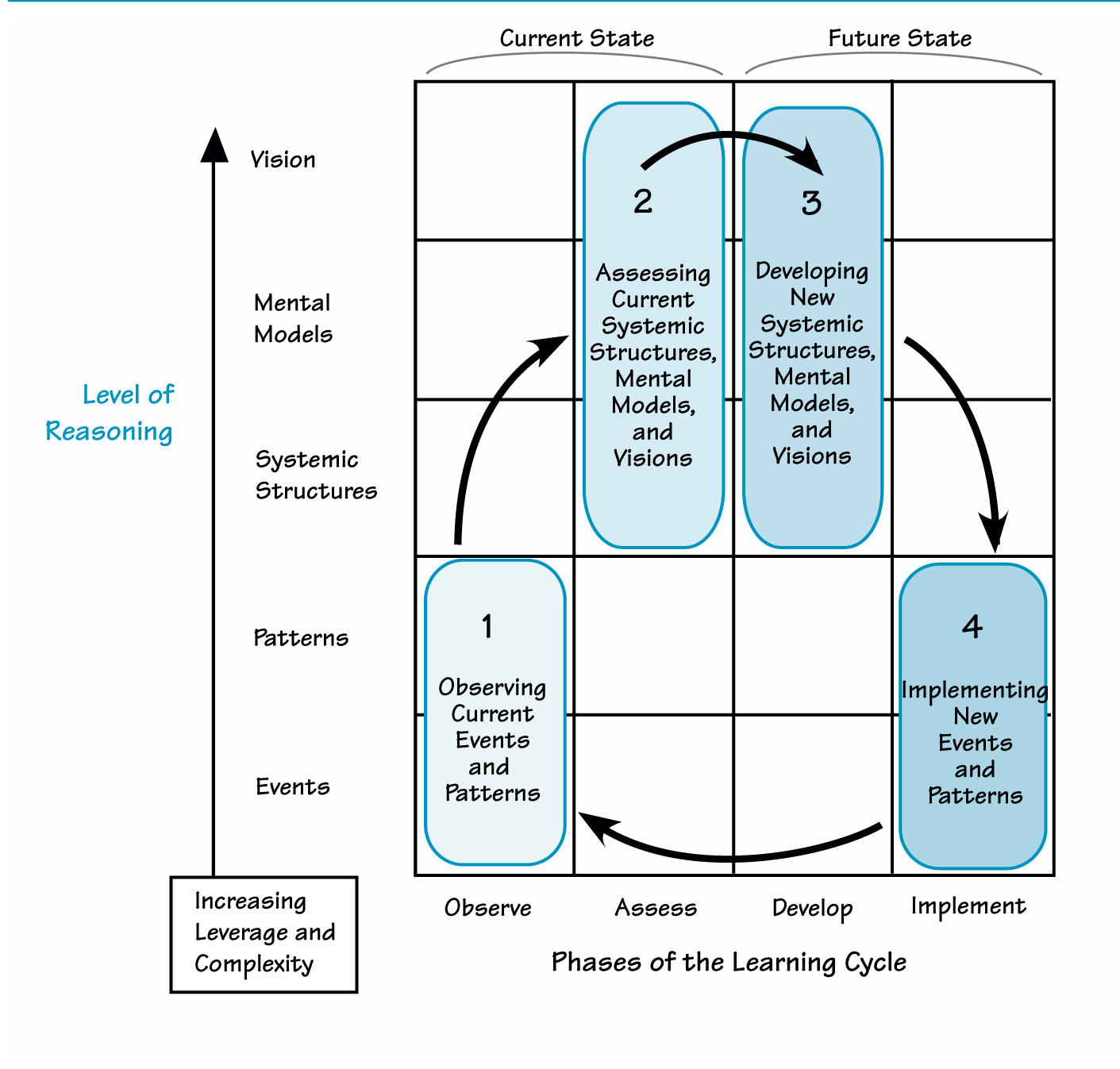
The Learning Action Matrix knits the learning disciplines into a system that provides a logical “map” to guide practitioners through a process that produces real results and continuous learning.
The four zones on the matrix are:
- Zone 1:Observe Current Events and Patterns
- Zone 2:Assess Current Systemic Structures, Mental Models, and Vision
- Zone 3:Develop New Systemic Structures, Mental Models, and Vision
- Zone 4:Implement New Events and Patterns
The arrows in the Learning Action Matrix show the logical progression through the four zones.
Progressing Through the Zones
Learning begins with observing events and patterns (Zone 1).
People make assessments about the underlying structures that drive the behavior they have observed (Zone 2).
They then work to develop new structures, based on that assessment (Zone 3).
They implement the new patterns of behavior suggested from the changed structures (Zone 4) and observe the results of these actions, initiating a second iteration of the learning cycle.
While the boundaries between the zones are not hard and fast (rarely does a group say “O. K. — done with Zone 2; let’s move on to 3!”), the zones are helpful for a number of reasons: There are different kinds of work that one must to do integrate reflection and action, and the zones do a good job describing these differing kinds of work. Observing what is (Zone 1) is different from developing ideas about what could be (Zone 3). The differences are “different enough” to be useful.
Knowing where you are can help you get to where you want to go. If you’re leaping from seeing something (Zone 1) to doing something (Zone 4) without reflecting (Zones 3 and 4), chances are you’ll create unwanted conditions. The matrix helps to direct careful, learning-oriented work by suggesting what to do next.
Finally, the zones provide a way for groups to quickly self-assess what type of work they’re doing now. My clients use the vocabulary of the zones as “sound bites” to describe what they see themselves doing. It’s a vocabulary that carries over beyond my work with them, which I really like.
The work that takes place in the different zones is discussed in more detail below.
Zones 1 and 2 in Detail
Here’s a detailed tour through the first two zones of the matrix.
Zone 1: Observing Events and Patterns.
In Zone 1, team members observe and report on events in the workplace; they tell stories that focus on “what happened” in a given situation. These organizational war stories are like potato chips — no one can tell just one.
But to gain leverage, storytelling must move up the axis from “Observing Events” to “Observing Patterns.” Recognizing a pattern begins with the simple insight that “this has happened before.”
Having teams identify the patterns in their work is useful for lifting conversation out of the Events level.
For example, one group was considering rolling out an update to a product development method when I asked, “How do you usually do this, and what usually happens?” One member responded immediately that their pattern was to announce changes through a large meeting like the one they were planning, and that very little usually happened as a result. (Notice how this constitutes Zone 1 work of “Observing Patterns.”) Others laughed in agreement. The moment was an important one, as they realized the truth of the cliché “If we do what we’ve always done, we’ll get what we’ve always gotten.”
Many of the best tools for Zone 1 work come from Total Quality. Statistical process control, with it’s ability to distinguish normal from special variation, supports a rigorous analysis of production patterns. Group process practices like multi-voting and affinity diagramming make clear patterns of opinion that a group holds but cannot articulate. Stripped of its elaborate architecture, Process Reengineering reveals itself as a process of replacing one work pattern with another more rational one, here moving from Zone 1 of the matrix to Zone 4.
Zone 2: Assessing Current Systemic Structures, Mental Models, and Vision.
Once group members have identified and described a pattern, they can begin to document the underlying systemic structure that maintains that pattern. This zone is usually the first one teams experiment with when they begin to practice the five disciplines. They try to draw causal loop diagrams to explain the patterns they identify and eagerly point out each other’s mental models. As individuals become more experienced in this practice, they recognize that they need to examine their own beliefs as well.
New practitioners frequently strive to create the “right” causal loop diagram to describe a pattern. More experienced practitioners learn to tolerate more complexity and thrive in the intricacies of contradiction. Eventually, deep and sustained work with causal loop diagramming and mental models leads to a vision-oriented understanding of “what we seem to be creating here.” Vision is the foundation for all of the levels below and exerts a powerful influence on the events, patterns, systemic structures, and mental models working in any given situation. The simple question “What do we seem to be creating here?” can often lead a group to state the obvious.
EXAMPLE OF ZONE 2 WORK
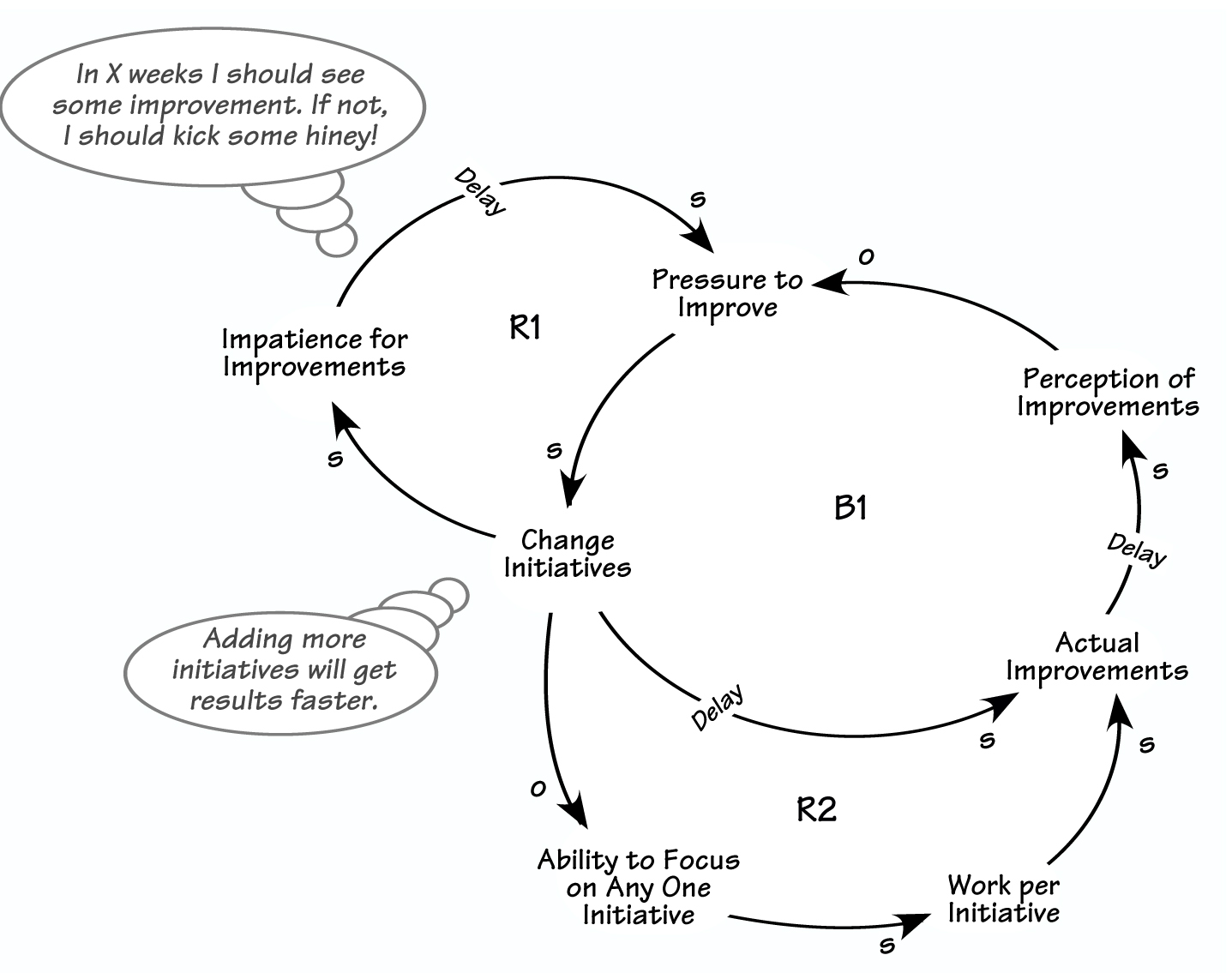
Loop B1 describes a balancing structure where pressure to improve leads to change initiatives, such as new teaching methods, sexuality education, anti-gang programs, and state-mandated curriculums. These initiatives lead to actual improvements and a perception that things are improving, but only after delays. Reinforcing loop R1 illustrates how new change initiatives actually increase impatience for improvements, which increases the pressure for improvements. R2 is a reinforcing loop, where each new initiative reduces the ability to focus on any single initiative, reducing the work and slowing the rate of actual improvement.
The group also identified mental models supporting a few of the key links in this system. These are indicated by the “thought bubbles” drifting off the links. In addition, they identified the highest level of “what we are creating here,” namely, a system in which the stereotype that schools resist change will lead to behavior (more and more initiatives), which will then reinforce this very perception.
I see groups working with “chaotic purpose” in this zone, jumping from working on causal loops to speculating on mental models to reflecting on the present culture (an “assessing vision” discussion) without resolving any of these issues. Teams in this zone, especially teams new to the disciplines, are like student archeologists wandering over an area they are convinced is an important historical site. The process of learning is iterative. They will need to dig in one spot several times before they become skilled enough to understand what’s there.
Zones 3 and 4 in Detail
Zone 3: Developing New Systemic Structures, Mental Models, and Vision.
While the work of Zone 2 is like an excavation, the work of Zone 3 is more creative, like the work of an architect or artist. Like all activities that relay on inspiration, it follows its own pace, oblivious to deadlines and urgency
Teams that skip this zone imperil their ability to implement in Zone 4. Without Zone 3 work, the actions of Zone 4 are just different versions of “what we’ve always done.” They have to be, because the team lacks the cognitive infrastructure (mental models), the causal infrastructure (systemic structures), and the aspiration (vision) to create anything else.
Teams sometimes begin work in Zone 3 by literally making something up that serves as a provisional vision of the way they want things to be. In fact, I find many groups already have reflected on their vision for the future, inspired by the fact that, as one manager told me, “Vision is hot right now.” However, their visions have remained castles in the air, with little hope of informing action directly. The development of new beliefs and systemic structures are needed to link these castles to the “ground” of Zone 4 implementation.
The work of Zone 2 is a necessary point of departure for the work of Zone 3, especially in the development of new systemic structures. These structures can be creatively recast by:
- Linking existing variables in a new way
- Breaking existing links between variables
- Reducing delays in the system. (Thanks to Innovation Associates for first putting this so clearly.)
Using these as redesign principles, groups can reconfigure the structures in which they find themselves.
Extending the example of the educators and their challenge managing change, let’s look at how this team developed a new systemic structure in response to their original loop (see “Zone 3 Loop and Its Strategies”). Their Zone 3 strategies are:
1. Break the link between “Impatience for Improvements” and “Pressure to Improve.”
2. Add a link between “Impatience for Improvements” and “Ability to Focus on Any One Initiative.”
3. Reduce the delays in B1 between “Change Initiatives” and “Actual Improvements” and between this variable and “Perception of Improvements.”
In Zone 4, they make these theoretical changes concrete.
Zone 4: Implementing New Events and Patterns.
Obviously, drawing or crossing out a link on paper changes nothing in the material world (other than the paper, of course). Zone 4 work demands that these paper changes be translated into actual actions.
For most groups, Zone 4 work is familiar territory. They are comfortable with the methods that make sense in this zone. After all, planning actions is what most traditional managers do most of the time. Especially useful are those simple methods that support team planning, such as making public commitments through action plans and accountability charting.
To return to our example, reducing the two delays in the balancing loop might involve some or all of the following actions:
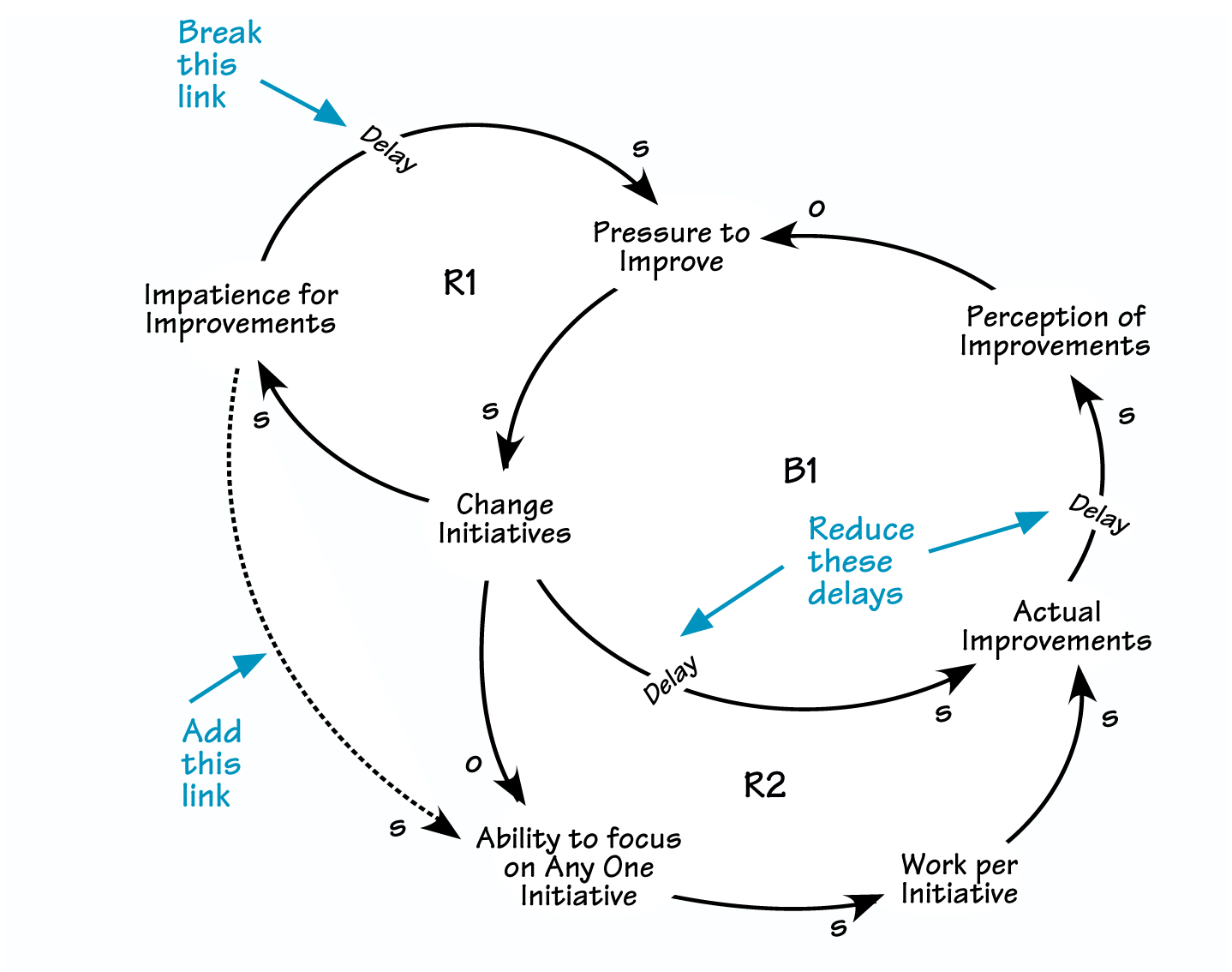
In “Example of Zone 2 Work,” a group of public school administrators impatient with the pace of change in their schools built the above causal loop diagram to describe what they saw.
Reduce these delays
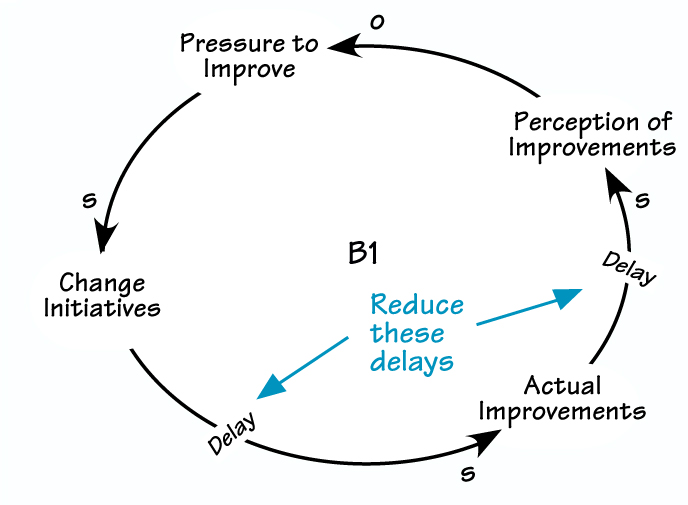
- Designing an initiative for early successes
- Improving something simple and visible early
- Starting work before announcing the initiative to have some successes in-hand (an old fund-raising trick)
- Lowering expectations regarding the speed of change
Obviously, the mental models identified in the original loop will need to be addressed along with the systemic dynamics. For example, the assumption that “In X weeks I should see some improvement. If not, something’s wrong” needs to yield to a belief more consistent with the actual pace of change.
The educators will need to determine how best to influence this belief, possibly choosing different approaches for different constituencies; i.e., one influences a governor differently than one influences a parents’ committee. In the case above, both constituencies will need to be influenced, since both are sources of change initiatives.
How might the educators accomplish their second strategy, breaking the link between “Impatience for Improvements” and “Pressure to Improve”?
Impatience for Improvements
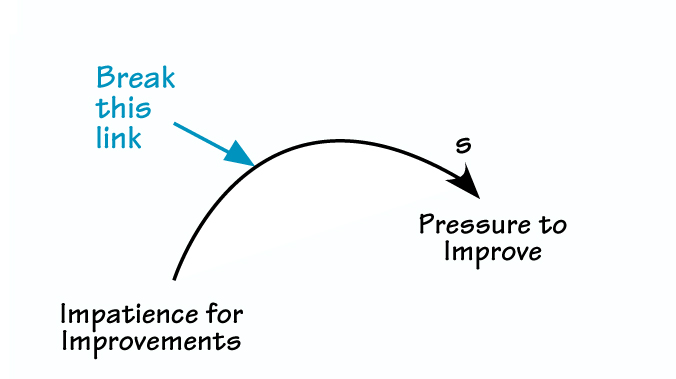
A strategy might include:
- Testing whether or not people believe that the causal loop diagram makes sense, and then
- Seeking their agreement to shift their impatience to increasing the focus on present initiatives
This last point represents an implementation of the strategy “Add a link between ‘Impatience for Improvements’ and ‘Ability to Focus on Any One Initiative.’”
Ability to Focus on Any One Initiative
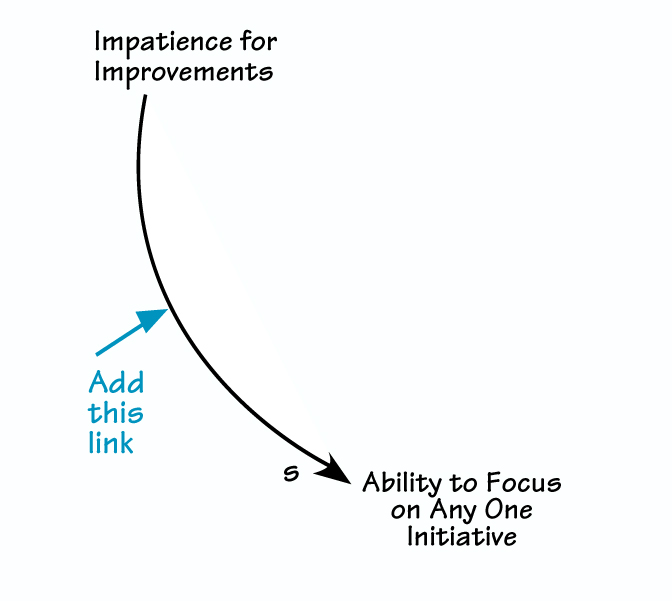
In addition, the educators could establish a pattern of having senior people visit the sites of present initiatives and publishing these visits in the school-system paper, along with statements that changes take time.
Typical Group Patterns
In moving through the four zones of work, groups often follow a similar developmental course as they becomes better able to integrate reflection (Zones 2 & 3) with action (Zones 1 & 4) in the service of learning and results.
Leaping to Action
Most teams initially move from Zone 1 directly to Zone 4 (see “Leaping to Action”). They see something happening (Observe) and they do something about it (Implement), without passing through the zones where they assess and develop new systemic structures, mental models, and vision.
LEAPING TO ACTION
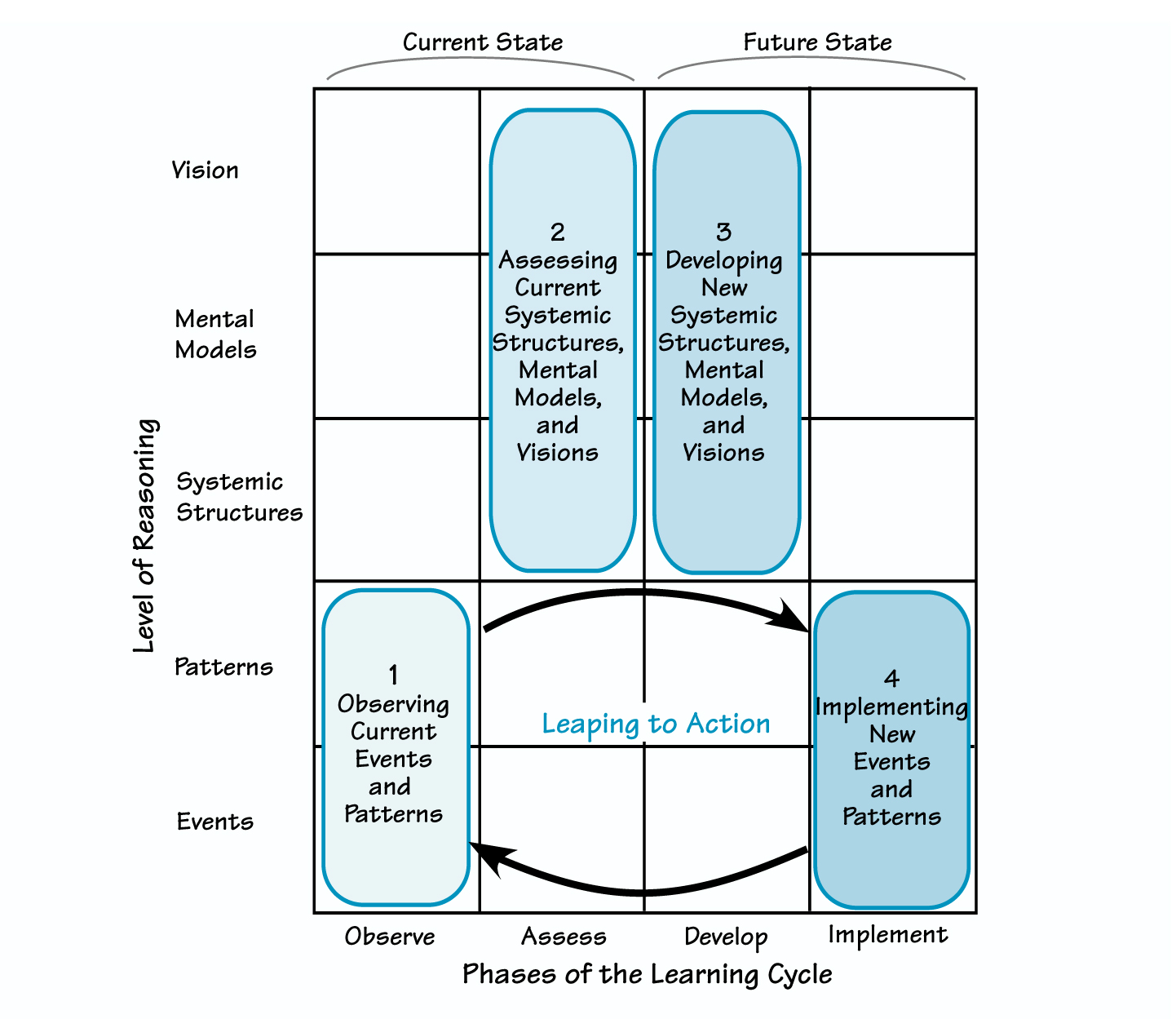
LOST IN SPACE
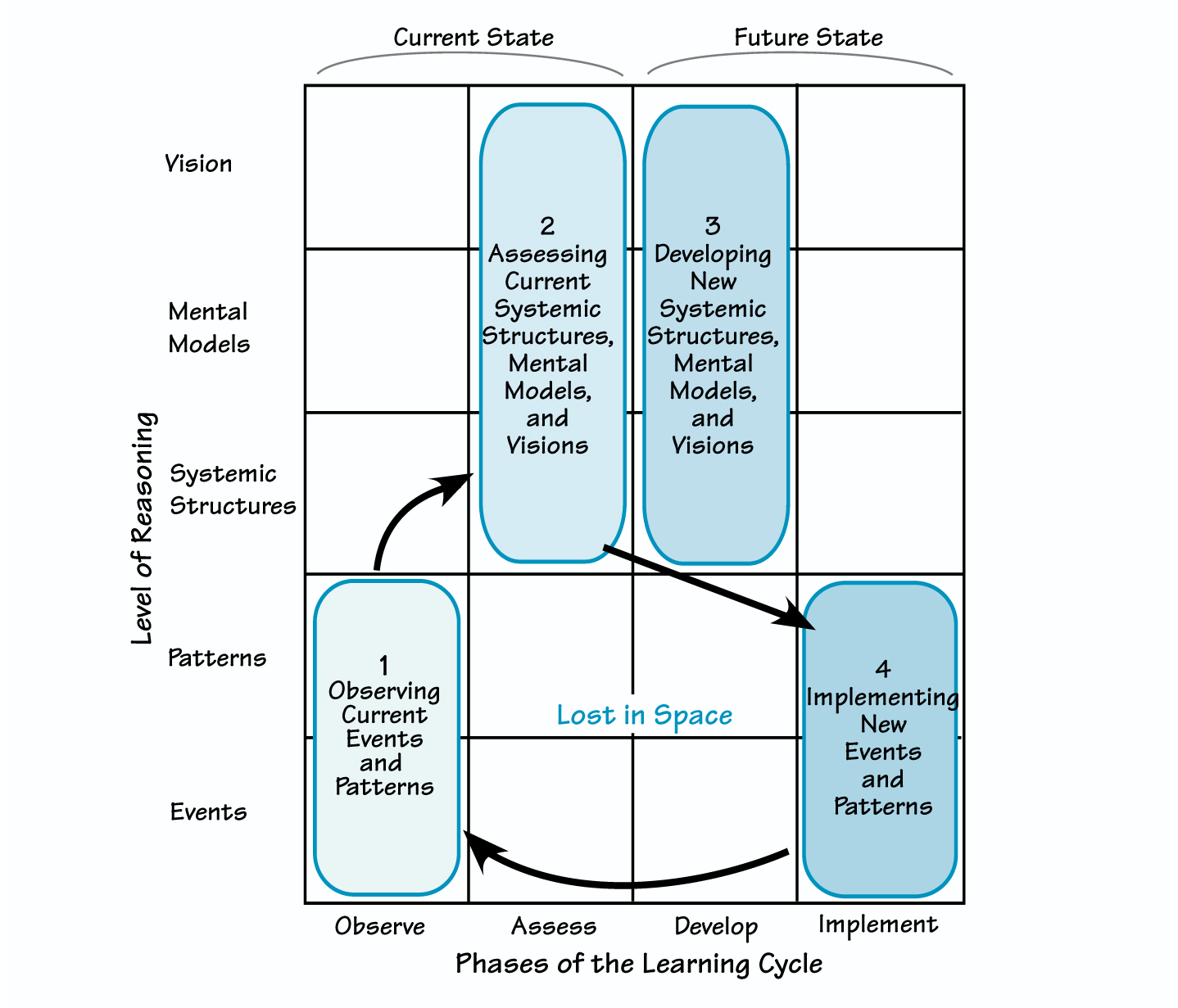
Groups often learn to self-diagnose and correct this “leaping to solutions” movement once they become familiar with the matrix. One member warning another that “You’re leaping to 4 and we aren’t even out of 1 yet!” slows the impulse to action and leads groups to the reflection of Zones 2 and 3.
Lost in Space As teams begin to learn the disciplines of organizational learning, they add Zone 2 work to their “Leaping to Action” habits, developing a “Zone 1/Zone 2/Zone 4” dance step, which one group called “Lost in Space” (see above).
Teams at this stage are able to use systems thinking and mental model disciplines to assess current reality in increasingly complex ways, yet they have difficulty using much of what they learn to implement new actions. They have usually learned just enough to see how the solutions they might have used in the past will not serve them in the long term, but have not learned enough to create new approaches. The result can be “analysis paralysis.”
Alternatively, when groups at this stage do take action, they can get into trouble. They haven’t yet developed the systemic structures or beliefs to underpin a desired future based on a new vision of what the team wants to create (Zone 3 work).
For example, one executive team I worked with used the matrix structure to redesign an organization. Working through Zones 1 and 2, they did a good job of describing current reality. However, once the outlines of a new organization began to emerge, they moved quickly to draw up the new pattern for the organization (Zone 4 work).
They presented this new organizational chart to their boss a few days later. Intrigued, he asked them to put some names on the positions on the chart. When they tried to assign the executive positions — their own slots — their agreement broke down, and part of the group went to the boss to retract the new design.
I now wonder what would have happened if they had developed a deeper understanding of the future they desired by working through Zone 3 in a disciplined manner, articulating the different beliefs they would have needed to function in this organization and developing the systemic structures to support these beliefs. At least, they might have confronted their own resistance to changing responsibilities.
Acknowledgments
As I mentioned earlier, the vertical axis “Levels of Reasoning” is borrowed from Daniel Kim’s “Vision Deployment Matrix™” (see “Vision Deployment Matrix™:A Framework for Large-Scale Change,” The Systems Thinker V6N1). His work, in turn, owes a debt to the “Iceberg Model” from Innovation Associates Systems Thinking curriculum, as do several other concepts from this article.
This piece benefited from early readings by Marty Castleberg, Peter Senge, and Janice Molloy. Several clients have advanced my understanding of how to apply the Matrix, most notably the Product Development Leadership and Learning Team at Harley-Davidson.
